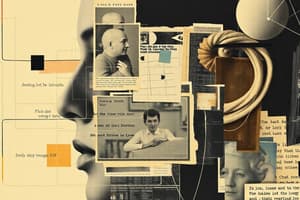Podcast
Questions and Answers
What is the primary goal of LLM-based autonomous agents?
What is the primary goal of LLM-based autonomous agents?
- To perform basic question-answering tasks
- To develop new programming architectures
- To compete with traditional machine learning models
- To autonomously fulfill diverse roles and learn from the environment (correct)
Which module in the unified framework is responsible for translating decisions into outputs?
Which module in the unified framework is responsible for translating decisions into outputs?
- Profiling module
- Memory module
- Planning module
- Action module (correct)
How does the profiling module influence the other modules in the framework?
How does the profiling module influence the other modules in the framework?
- It directly replaces the planning module
- It governs the planning and action modules only
- It influences both memory and planning modules (correct)
- It has no significant impact on other modules
What is analogous to designing the architecture of LLM-based agents in traditional machine learning?
What is analogous to designing the architecture of LLM-based agents in traditional machine learning?
What kind of environment do LLM-based autonomous agents operate within, according to the framework?
What kind of environment do LLM-based autonomous agents operate within, according to the framework?
Which of the following best describes the relationship between agent capability acquisition and LLM fine-tuning?
Which of the following best describes the relationship between agent capability acquisition and LLM fine-tuning?
What role does the memory module play in the agent architecture framework?
What role does the memory module play in the agent architecture framework?
What is a significant challenge in building LLM-based autonomous agents beyond QA tasks?
What is a significant challenge in building LLM-based autonomous agents beyond QA tasks?
Flashcards
LLM-Based Autonomous Agent
LLM-Based Autonomous Agent
An LLM-based autonomous agent is a system that uses a large language model (LLM) to perform tasks autonomously.
Agent Architecture Design
Agent Architecture Design
An architecture design that defines modules for an agent to interact with the world, including profiling, memory, planning, and action modules.
Profiling Module
Profiling Module
The profiling module determines the specific role of the agent, like being a helper, a teacher, or a researcher.
Memory Module
Memory Module
Signup and view all the flashcards
Planning Module
Planning Module
Signup and view all the flashcards
Action Module
Action Module
Signup and view all the flashcards
Agent Capability Acquisition
Agent Capability Acquisition
Signup and view all the flashcards
Fine-tuning LLMs
Fine-tuning LLMs
Signup and view all the flashcards
Study Notes
LLM-Based Autonomous Agents
- LLM-based autonomous agents aim to perform diverse tasks using human-like LLM capabilities.
- Two key aspects are crucial: architecture design and agent capability acquisition.
- Designing the agent architecture is like defining the network structure in traditional machine learning.
- Agent capability acquisition is akin to learning network parameters.
- Recent LLM advancements excel in question-answering (QA) but fall short of autonomous agents.
Agent Architecture Design
- A key challenge is bridging the gap between LLMs and autonomous agents.
- Rational agent architectures are needed to enhance LLM capabilities.
- Existing work developed various modules to improve LLMs.
- A unified framework is proposed, illustrated in Figure 2.
- The framework includes:
- Profiling module: identifies agent role.
- Memory module: enables recalling past actions.
- Planning module: allows for future action planning.
- Action module: translates decisions into outputs.
- The profiling module influences the memory and planning modules, which collectively affect the action module.
Studying That Suits You
Use AI to generate personalized quizzes and flashcards to suit your learning preferences.




